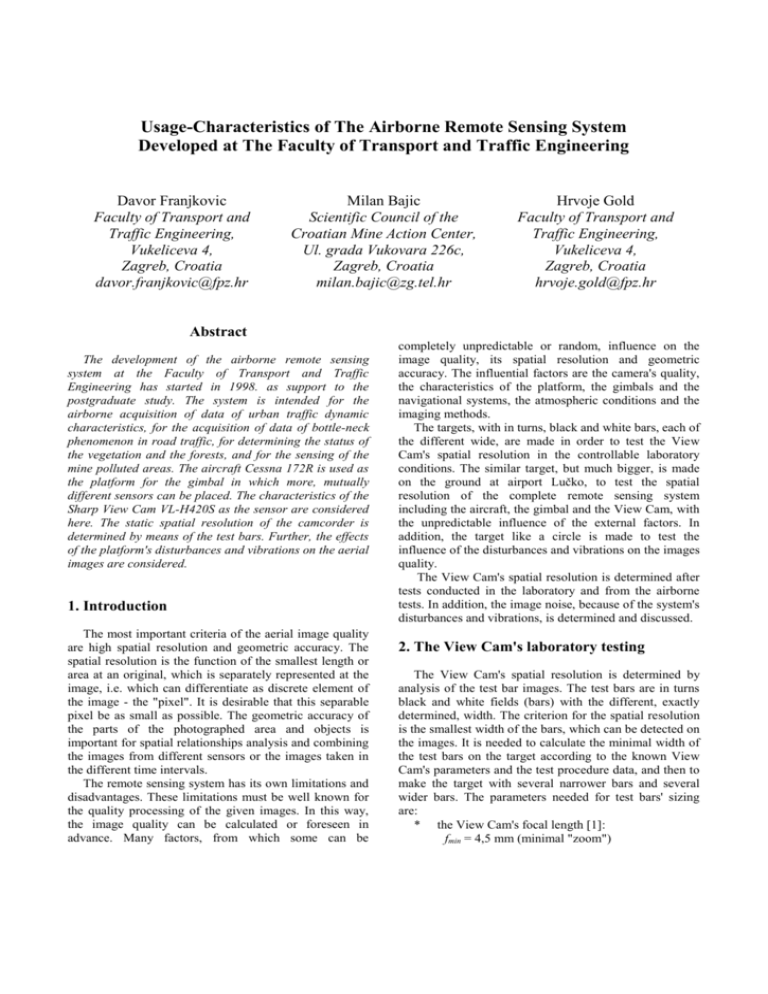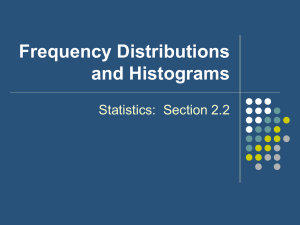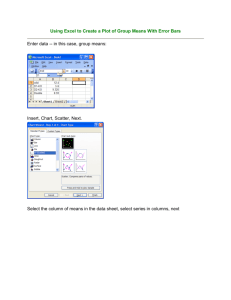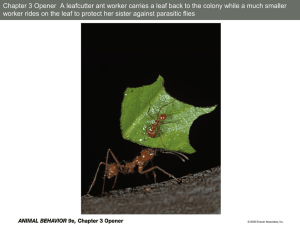Characteristics of The Airborne Remote Sensing System at The
advertisement

Usage-Characteristics of The Airborne Remote Sensing System Developed at The Faculty of Transport and Traffic Engineering Davor Franjkovic Faculty of Transport and Traffic Engineering, Vukeliceva 4, Zagreb, Croatia davor.franjkovic@fpz.hr Milan Bajic Scientific Council of the Croatian Mine Action Center, Ul. grada Vukovara 226c, Zagreb, Croatia milan.bajic@zg.tel.hr Hrvoje Gold Faculty of Transport and Traffic Engineering, Vukeliceva 4, Zagreb, Croatia hrvoje.gold@fpz.hr Abstract The development of the airborne remote sensing system at the Faculty of Transport and Traffic Engineering has started in 1998. as support to the postgraduate study. The system is intended for the airborne acquisition of data of urban traffic dynamic characteristics, for the acquisition of data of bottle-neck phenomenon in road traffic, for determining the status of the vegetation and the forests, and for the sensing of the mine polluted areas. The aircraft Cessna 172R is used as the platform for the gimbal in which more, mutually different sensors can be placed. The characteristics of the Sharp View Cam VL-H420S as the sensor are considered here. The static spatial resolution of the camcorder is determined by means of the test bars. Further, the effects of the platform's disturbances and vibrations on the aerial images are considered. 1. Introduction The most important criteria of the aerial image quality are high spatial resolution and geometric accuracy. The spatial resolution is the function of the smallest length or area at an original, which is separately represented at the image, i.e. which can differentiate as discrete element of the image - the "pixel". It is desirable that this separable pixel be as small as possible. The geometric accuracy of the parts of the photographed area and objects is important for spatial relationships analysis and combining the images from different sensors or the images taken in the different time intervals. The remote sensing system has its own limitations and disadvantages. These limitations must be well known for the quality processing of the given images. In this way, the image quality can be calculated or foreseen in advance. Many factors, from which some can be completely unpredictable or random, influence on the image quality, its spatial resolution and geometric accuracy. The influential factors are the camera's quality, the characteristics of the platform, the gimbals and the navigational systems, the atmospheric conditions and the imaging methods. The targets, with in turns, black and white bars, each of the different wide, are made in order to test the View Cam's spatial resolution in the controllable laboratory conditions. The similar target, but much bigger, is made on the ground at airport Lučko, to test the spatial resolution of the complete remote sensing system including the aircraft, the gimbal and the View Cam, with the unpredictable influence of the external factors. In addition, the target like a circle is made to test the influence of the disturbances and vibrations on the images quality. The View Cam's spatial resolution is determined after tests conducted in the laboratory and from the airborne tests. In addition, the image noise, because of the system's disturbances and vibrations, is determined and discussed. 2. The View Cam's laboratory testing The View Cam's spatial resolution is determined by analysis of the test bar images. The test bars are in turns black and white fields (bars) with the different, exactly determined, width. The criterion for the spatial resolution is the smallest width of the bars, which can be detected on the images. It is needed to calculate the minimal width of the test bars on the target according to the known View Cam's parameters and the test procedure data, and then to make the target with several narrower bars and several wider bars. The parameters needed for test bars' sizing are: * the View Cam's focal length 1: fmin = 4,5 mm (minimal "zoom") fmax = 36 mm (maximal "zoom", enlargement 8x) the height of the View Cam's pickup device 1: ysen = 1/4” = 6,35 mm * the width/height ratio is taken standard: xsen : ysen = 4 : 3 * the width and the diagonal of the View Cam's pickup device: xsen = 8,47 mm lsen = 10,58 mm * the number of the image lines on View Cam's pickup device is taken standard: N = 400 * the distance from camera to the target: H=6m The width of the test bars pair ds which are copied on the camera's pickup device is determined by the ratio of the pickup device height ysen and the number of the image lines N: ds y y (1) sen ; d s 2 sen . 2 N N * The term ds represents total width of one pair: one black and one white bar. The next ratio follows from Figure 1: H D H D ds ; (2) f ds f and then the needed width of the test bars pair on the target can be obtained from (1) and (2): D 2 ysen H N f (3) The insertion of the above mentioned parameters will give the minimal width of the test bars pair: D 2 y sen H 6,35 6000 2 5,2914 mm N f 400 36 (4) On the basis of above result, the target for the camera's spatial resolution determining is made. The width of 2 mm is taken for the width of the minimal test bar pair, i.e. the first black bar is 1 mm wide. This width is enough smaller then the calculated minimal width from equation (4), so the target can be used for cameras with the bigger focal length (the bigger "zoom") or for the smaller distance from the camera to the target. The two adjacent test bars are different for the scale factor 6 2 what is the satisfying difference for the camera's spatial resolution determining 5. Therefore, the width of the n-th test bar is: Dn D1 6 2(n1) . (5) A total of the 31 black test bars are painted on the white background. The last, 31st black bar is 32 mm wide. The total dimensions of the target are 570,28 X 570 mm. The angle of the camera's coverage, with the maximal "zoom", according to the Figure 1, is equal: 2 arcsin y sen 6,35 2 arcsin 10,119 o . 2 f 2 36 (6) The target is shot by the View Cam Sharp VL-H420S, both placed in the equal level, at the distance of 6 m with good lighting. The video image is transported from the View Cam through the video recorder to the computer by the VidCap 32 program. The digitalized images of the test bars are saved in the JPG and TIF format (Figure 2.). Figure 1. The geometry of the View Cam's pickup device and target The width of the test bars is proportional to the height of the camera's pickup device ysen and to the distance from the camera to the target H, and is in inverse proportion to the number of the image lines N on the pickup device and to the focal length f, according to the equation (3). Therefore, the minimal width of the test bars pair is obtained for the maximal focal length (maximal "zoom"). Figure 2. The image of the test bars shot vertically The further processing of the images is performed by the MicroImages TNTlite 5.6 program [6], and the profiles and the first derivations are obtained for the horizontally and vertically shot target. The maximums indicate the largest intensity of the white, and the minimums indicate the largest intensity of the black on the profiles' diagrams (Figure 3.). On the diagrams of the first derivations (Figure 4.), the maximums take place where the transition from the black to the white occur, and the minimums denote the transition from the white to the black, looking from the left to the right. ds D f 36 5,04 0,03024 mm H 6000 (7) The camera has the equal spatial resolution in the horizontal and vertical direction. The width of the narrowest separable test bar (5,04 mm) is approximately equal to the earlier predicted width (5,3 mm). On the basis of the equation (2) and the dimensions of the minimal separable "pixel" on the camera's pickup device (0,03024 X 0,03024 mm), the size of the minimal separable "pixel" on the real object or on the ground can be determined, depending on the distance from the camera to the object (the flight altitude for the airborne shooting) and on the camera's focal length. 3. The spatial resolution of the View cam in the flight Figure 3. The profiles of the test bars Figure 4. The first derivations of the test bars The number of the visible (separable) test bars can be obtained by the simple counting of the profiles' minimums or the first derivations' minimums for both, the vertically and horizontally shot test bars. The number of the inseparable test bars is obtained if the number of the separable test bars is subtracted from the total number of test bars, i.e. 31. This is shown in the Table 1. where the width of the minimal visible test bar is calculated according to the equation (5). Table 1. The analysis of the test bars' profiles and first derivations Test bars... Vertical Horizontal Separable Inseparable 23 23 8 8 The width of the narrowest visible pair 5,04 mm 5,04 mm Therefore, the camera can separate the black/white pair which width is 5,04 mm, for the given shooting conditions (H = 6 m, f = 36 mm). According to equation (2) the width of the narrowest black/white test bar on the camera's pickup device amounts: The calculation of the test bars on the ground for the airborne camera testing is made for the flight altitudes of 300 and 600 meters. The test bars are painted by the permanent white paint on the dark asphalted background. The minimal needed width of the test bars is determined in the same way as for the laboratory testing. Since the minimal separable width of the test bars on the camera’s pickup device is known now (ds = 0,03024 mm), the minimal width of the black/white pair on the target for above mentioned altitudes, according to equation (2), should be: * for H = 300 m: H 300 D ds 0,03024 252 mm (8) f 0,036 * and for H = 600 m: H 600 D d s 0,03024 504 mm f 0,036 (9) By analogy as for the laboratory targets, several test bars narrower than the minimal width D = 252 mm, and several test bars wider than the minimal width D = 504 mm are painted, so that the target can be used for the both expected flight altitudes. If the scale factor 6 2 is again used, it means that five test bars come between two obtained minimal width, and the seven test bars including these two extreme values. Beside these seven test bars, five narrower and six wider test bars are painted. Therefore, according to the camera's characteristics known so far, the 13 test bars are expected to be separable from the 300 m altitude and the seven test bars are expected to be visible from the 600 m altitude. However, the number of the visible test bars can be different from these foreseen data because of the specific conditions of airborne shooting, which can be significantly different from laboratory conditions. The narrowest painted white bar is 70,7 mm wide, and the last, the widest, 18 th white bar is 504 mm wide. The total dimensions of target are 8084,2 X 8000 mm. The camera is placed in the specially designed gimbal with the two degrees of freedom: the rotation of 360 degrees in the horizontal plane and the rotation of 180 degrees in the vertical plane. The gimbal is hanged up on the side of the baggage compartment of the Cessna 172R aircraft (Figure 5.). The “zoom” and the orientation of the camera are controllable from the aircraft’s cabin. The preview image is also available on the special display or on the notebook computer. The same images are used for the analysis of the platform's disturbances, as for the determining of the spatial resolution from the air, but attention is now dedicated to the target - the circle. The video of the target, recorded in the flight at the known altitudes, is re-taped from the Hi-8 to the VHS format. After that, the series of the successive half-images (a total of 132 half-images) is digitalized by the VidCap 32 program. The images are further processed by the Adobe Photoshop 5.0 program so that the co-ordinates of the target's center (in "pixels") are determined. The co-ordinates of the target's center are shown in the Figure 8. Figure 5. The gimbal hanged up on the aircraft Only one flight was been undertaken to determine camera’s spatial resolution for the airborne shooting, until now, but obtained images was of so poor quality that the further processing of these images is impossible for this purpose (Figure 6.). Figure 6. The image of the target from the air 4. The determining of the disturbances from the airborne platform The target (a circle) for the determining of the disturbances which the airborne platform enters in the aerial images, must be visible from the 600 m altitude, therefore, the target's minimal dimension must be greater then D = 504 mm. With respect to this demand, the white circle between the diameters of 600 and 900 mm are painted (Figure 7, designated by arrow). Figure 7. The target shot from the air and dimensions needed for the calculation Figure 8. The read co-ordinates of the target's center and the regression polynomial (lighter) The dimensions of the images are 767 X 575 pixels and the co-ordinates represent the distance of the target's center to the origin in the upper left corner of the images. The statistical analysis is performed by the Microsoft Excel and Analyse-It programs. The total of n = 132 data, i.e. the 132 pairs of the x, y co-ordinates are processed. The coefficients of the regression's polynomial (of the 6 th order) are determined, so that the next polynomial are obtained: x 4,63095 10 13 y 6 1,09109 10 9 y 5 9,92439 10 7 y 4,46378 10 4 4 y 3 (10) base for the further investigation of the platform's and camera's dynamic characteristics. 1,05437 10 1 y 2 1,24328 10 1 y 4,11872 10 1 The regression's polynomial is a smooth curve, and the deviations (the rests, the differences) between the read coordinates x and the values of the polynomial represent the shift of the target's center, which are the consequence of the platform's disturbances and vibrations. The deviations for every single half-image are shown in the Figure 9. Figure 10. The distribution of the rests On the basis of the known dimensions of the target (8084 X 8000 mm), the measured dimensions from the image (Figure 8, the CorelDraw program) and the known dimensions of the image (767 X 575 pixels), the ratio of the real length on the ground to the length of one pixel on the image, by application of the simple ratios, is obtained: Figure 9. The deviations for every single half-image If the differences are classified in the intervals of the two pixels width and after counting the number of the rests in the every single interval, the diagram of the distribution is obtained. The number of the rests in the every interval is shown in the Table 2. and the diagram of the distribution is shown in the Figure 10. Table 2. The distribution of the rests The range of the deviations The number of the half-images (-10,-8] (-8,-6] (-6,-4] (-4,-2] (-2,0] (0,2] (2,4] (4,6] (6,8] (8,10] 1 3 11 19 27 40 18 12 1 0 From Figure 10. it is evident that the distribution satisfies the form of the Gauss or normal distribution. It means that majority of the data lies close to the regressions polynomial, i.e. its deviations are small. The data about deviations (Figure 9. and 10, Table 2.) are the 104 ,64 mm 8m m 0,408 575 pixel 3,57 mm pixel (11) Knowing this ratio, all data expressed in "pixels" can be transformed in form of the length expressed in "meters" and further processed. 5. Conclusions In this paper, the spatial resolution of the Sharp VLH420S View Cam is determined in the laboratory conditions. The targets with the test bars are made, the shooting is conducted in determined, known conditions and the dimensions of the minimal separable "pixel" are fixed after the images' processing. On the basis of this fact, the dimensions of the minimal separable "pixel" on the images, the ground or the real object can be simply determined, if the data about the distance between the camera and the target and applied "zoom" are known. In the next step, the target for the determining of the camera's spatial resolution from the air in real conditions is made. The camera's spatial resolution from flight is not fixed because of poor quality of the obtained aerial images. The form and distribution of the airborne platform's (aircraft Cessna 172R, associated gimbal, Sharp VL-H420S View Cam and accessories) disturbances and vibrations and their effects on the aerial images are defined by shooting the target - a circle - from the known altitudes. The deviations of the target's coordinates from the predicted trajectory of the aircraft (represented by the regression's polynomial) satisfy Gauss distribution what means that the level of the disturbances is adequately small. Consequently, the several important characteristics of this camera and of the airborne platform are determined. The obtained characteristics can be adequately used in the further exploitation of this remote sensing system. 6. References [1] SHARP View Cam model VL-H420S & VL-H4200S Operation Manual, SHARP Corporation, Osaka, Japan [2] Pilot’s Operating Handbook and FAA Approved Airplane Flight Manual – The Cessna Aircraft Company, Model 172R, The Cessna Aircraft Company, Wichita, Kansas, USA, 1996. [3] M. Bajic, H. Gold, T. Fiedler: Spaceborne and airborne remote sensing and electronic reconnaissance, Handouts, Postgraduate Studies, Faculty of Transport and Traffic Engineering, Zagreb, 1998. (in Croatian) [4] M. Bajic, H. Gold, D. Franjkovic: "Development of the Airborne Remote sensing system for the urban traffic research", Proceedings of International Conference "Traffic in Transitional Conditions – Intelligent Transport Systems and their Interfaces", TTC – ITSI ’99, Dubrovnik, October 1999, Promet – Traffic – Traffico, Supplement No. 4, Vol. 11, Portoroz, Trieste, Zagreb, 1999, pp. 137-142. [5] R. Kuittinen, E. Ahokas, P. Järvelin: "Transportable Testbar Targets and Microdensitometer Measurements - A Method to Control the Quality of Aerial Imagery", International Archives of Photogrammetry and Remote Sensing, Vol. XXXI, Part B1, Vienna, 1996. [6] Reference Manual www.microimages.com for the TNT products V5.6,






